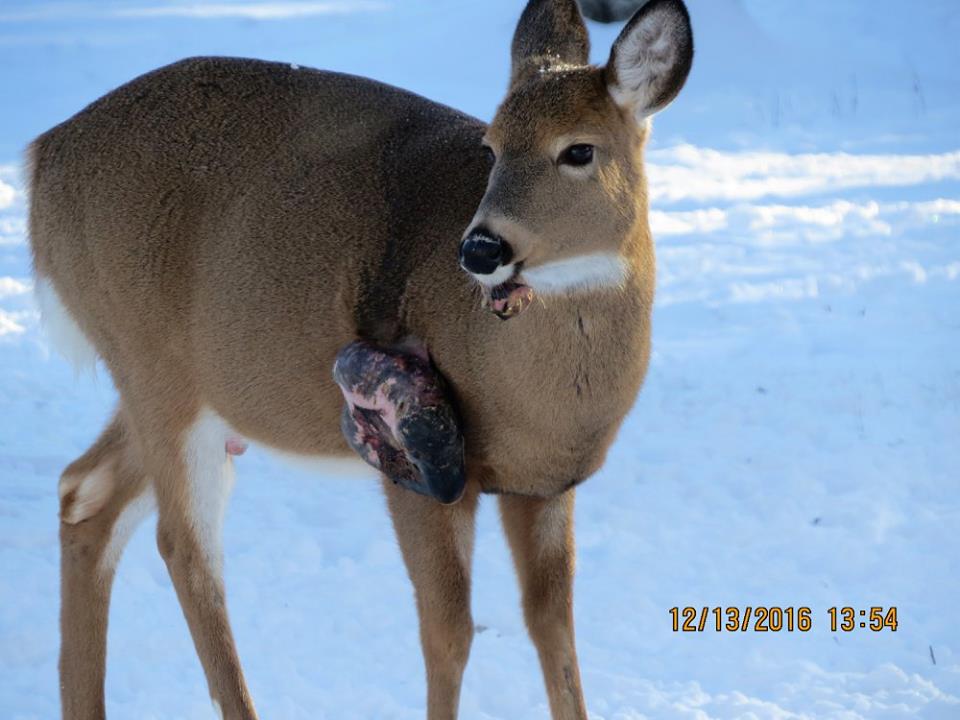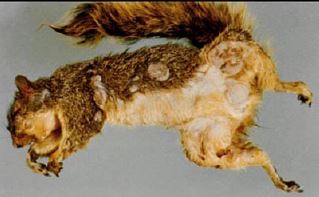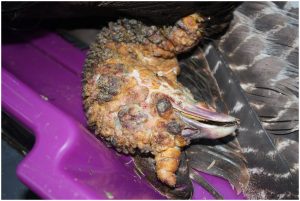March 29, 2017 at 11:56 am
By Henry Jones, Wildlife Biologist, Region C
There has been a recent flurry of reports of wildlife, ranging from deer to squirrels to crows, with odd growths or lumps in the Downeast Region. So what is going on?
[caption id="attachment_2216" align="alignleft" width="262"] Deer with fibromas; photo courtesy Donna Melanson[/caption]
[caption id="attachment_2217" align="alignright" width="279"]
Deer with fibromas; photo courtesy Donna Melanson[/caption]
[caption id="attachment_2217" align="alignright" width="279"] Squirrel with fibromas; photo courtesy Michigan DNR[/caption]
[caption id="attachment_2218" align="alignright" width="300"]
Squirrel with fibromas; photo courtesy Michigan DNR[/caption]
[caption id="attachment_2218" align="alignright" width="300"] Wild turkey with avian pox; Photo courtesy Kelsey Sullivan[/caption]
In some cases these growths are caused by a virus; generally papillomavirus in deer, poxvirus in rabbits and squirrels, and avipoxvirus in birds. Papillomavirus and poxvirus cause fibromas which are typically firm, round, hairless, nodular cutaneous masses that may become wrinkled and ulcerated and vary in number (1 to many) and size (0.1-8.0 inches diameter). These fibromas are usually benign, except when they limit mobility, vision, or nearby organ function (rare). Avipoxvirus in birds is often more serious and has two forms, cutaneous and diptheritic. The cutaneous form develops as crusty nodules in unfeathered areas (feet, legs, base of the beak, eye margins, and head) which may impede vision, feeding, and/or mobility. The diptheritic form develops as raised yellow plaques in the mouth and throat that may restrict air or food intake, resulting in mortality. There is no effective treatment for infected wildlife, but the fibromas and nodules may regress over multiple months in animals that have properly functioning immune systems provided there was not secondary bacterial infection.
These viruses are host species specific with global distribution; they are not known to infect humans. Transmission occurs via contact with open skin and by biting insects (primarily mosquitoes and fleas) that have recently fed on an infected individual. Papillomavirus and poxvirus may impact individuals, but rarely have an influence at the population level. Avian pox can occur in outbreaks that affect the local population.
Supplemental feeding congregates wildlife and promotes transmission of all these viruses through more frequent direct/indirect contact. Yet another great reason to refrain from the supplemental feeding of wildlife!
Sources
Michigan Department of Natural Resources. Wildlife Disease. Avian Pox. http://www.michigan.gov/dnr/0,4570,7-153-10370_12150_12220-26362--,00.html
Northeast Wildlife Disease Cooperative. Disease Fact Sheets. Avian Pox. https://sites.tufts.edu/nwdc/disease-fact-sheets/
Northeast Wildlife Disease Cooperative. Disease Fact Sheets. Fibromas. https://sites.tufts.edu/nwdc/disease-fact-sheets/
Pennsylvania Game Commission. Wildlife Related Diseases. Fibromas. http://www.pgc.pa.gov/Wildlife/Wildlife-RelatedDiseases/Pages/default.aspx
Wild turkey with avian pox; Photo courtesy Kelsey Sullivan[/caption]
In some cases these growths are caused by a virus; generally papillomavirus in deer, poxvirus in rabbits and squirrels, and avipoxvirus in birds. Papillomavirus and poxvirus cause fibromas which are typically firm, round, hairless, nodular cutaneous masses that may become wrinkled and ulcerated and vary in number (1 to many) and size (0.1-8.0 inches diameter). These fibromas are usually benign, except when they limit mobility, vision, or nearby organ function (rare). Avipoxvirus in birds is often more serious and has two forms, cutaneous and diptheritic. The cutaneous form develops as crusty nodules in unfeathered areas (feet, legs, base of the beak, eye margins, and head) which may impede vision, feeding, and/or mobility. The diptheritic form develops as raised yellow plaques in the mouth and throat that may restrict air or food intake, resulting in mortality. There is no effective treatment for infected wildlife, but the fibromas and nodules may regress over multiple months in animals that have properly functioning immune systems provided there was not secondary bacterial infection.
These viruses are host species specific with global distribution; they are not known to infect humans. Transmission occurs via contact with open skin and by biting insects (primarily mosquitoes and fleas) that have recently fed on an infected individual. Papillomavirus and poxvirus may impact individuals, but rarely have an influence at the population level. Avian pox can occur in outbreaks that affect the local population.
Supplemental feeding congregates wildlife and promotes transmission of all these viruses through more frequent direct/indirect contact. Yet another great reason to refrain from the supplemental feeding of wildlife!
Sources
Michigan Department of Natural Resources. Wildlife Disease. Avian Pox. http://www.michigan.gov/dnr/0,4570,7-153-10370_12150_12220-26362--,00.html
Northeast Wildlife Disease Cooperative. Disease Fact Sheets. Avian Pox. https://sites.tufts.edu/nwdc/disease-fact-sheets/
Northeast Wildlife Disease Cooperative. Disease Fact Sheets. Fibromas. https://sites.tufts.edu/nwdc/disease-fact-sheets/
Pennsylvania Game Commission. Wildlife Related Diseases. Fibromas. http://www.pgc.pa.gov/Wildlife/Wildlife-RelatedDiseases/Pages/default.aspx
 Deer with fibromas; photo courtesy Donna Melanson[/caption]
[caption id="attachment_2217" align="alignright" width="279"]
Deer with fibromas; photo courtesy Donna Melanson[/caption]
[caption id="attachment_2217" align="alignright" width="279"] Squirrel with fibromas; photo courtesy Michigan DNR[/caption]
[caption id="attachment_2218" align="alignright" width="300"]
Squirrel with fibromas; photo courtesy Michigan DNR[/caption]
[caption id="attachment_2218" align="alignright" width="300"] Wild turkey with avian pox; Photo courtesy Kelsey Sullivan[/caption]
In some cases these growths are caused by a virus; generally papillomavirus in deer, poxvirus in rabbits and squirrels, and avipoxvirus in birds. Papillomavirus and poxvirus cause fibromas which are typically firm, round, hairless, nodular cutaneous masses that may become wrinkled and ulcerated and vary in number (1 to many) and size (0.1-8.0 inches diameter). These fibromas are usually benign, except when they limit mobility, vision, or nearby organ function (rare). Avipoxvirus in birds is often more serious and has two forms, cutaneous and diptheritic. The cutaneous form develops as crusty nodules in unfeathered areas (feet, legs, base of the beak, eye margins, and head) which may impede vision, feeding, and/or mobility. The diptheritic form develops as raised yellow plaques in the mouth and throat that may restrict air or food intake, resulting in mortality. There is no effective treatment for infected wildlife, but the fibromas and nodules may regress over multiple months in animals that have properly functioning immune systems provided there was not secondary bacterial infection.
These viruses are host species specific with global distribution; they are not known to infect humans. Transmission occurs via contact with open skin and by biting insects (primarily mosquitoes and fleas) that have recently fed on an infected individual. Papillomavirus and poxvirus may impact individuals, but rarely have an influence at the population level. Avian pox can occur in outbreaks that affect the local population.
Supplemental feeding congregates wildlife and promotes transmission of all these viruses through more frequent direct/indirect contact. Yet another great reason to refrain from the supplemental feeding of wildlife!
Sources
Michigan Department of Natural Resources. Wildlife Disease. Avian Pox. http://www.michigan.gov/dnr/0,4570,7-153-10370_12150_12220-26362--,00.html
Northeast Wildlife Disease Cooperative. Disease Fact Sheets. Avian Pox. https://sites.tufts.edu/nwdc/disease-fact-sheets/
Northeast Wildlife Disease Cooperative. Disease Fact Sheets. Fibromas. https://sites.tufts.edu/nwdc/disease-fact-sheets/
Pennsylvania Game Commission. Wildlife Related Diseases. Fibromas. http://www.pgc.pa.gov/Wildlife/Wildlife-RelatedDiseases/Pages/default.aspx
Wild turkey with avian pox; Photo courtesy Kelsey Sullivan[/caption]
In some cases these growths are caused by a virus; generally papillomavirus in deer, poxvirus in rabbits and squirrels, and avipoxvirus in birds. Papillomavirus and poxvirus cause fibromas which are typically firm, round, hairless, nodular cutaneous masses that may become wrinkled and ulcerated and vary in number (1 to many) and size (0.1-8.0 inches diameter). These fibromas are usually benign, except when they limit mobility, vision, or nearby organ function (rare). Avipoxvirus in birds is often more serious and has two forms, cutaneous and diptheritic. The cutaneous form develops as crusty nodules in unfeathered areas (feet, legs, base of the beak, eye margins, and head) which may impede vision, feeding, and/or mobility. The diptheritic form develops as raised yellow plaques in the mouth and throat that may restrict air or food intake, resulting in mortality. There is no effective treatment for infected wildlife, but the fibromas and nodules may regress over multiple months in animals that have properly functioning immune systems provided there was not secondary bacterial infection.
These viruses are host species specific with global distribution; they are not known to infect humans. Transmission occurs via contact with open skin and by biting insects (primarily mosquitoes and fleas) that have recently fed on an infected individual. Papillomavirus and poxvirus may impact individuals, but rarely have an influence at the population level. Avian pox can occur in outbreaks that affect the local population.
Supplemental feeding congregates wildlife and promotes transmission of all these viruses through more frequent direct/indirect contact. Yet another great reason to refrain from the supplemental feeding of wildlife!
Sources
Michigan Department of Natural Resources. Wildlife Disease. Avian Pox. http://www.michigan.gov/dnr/0,4570,7-153-10370_12150_12220-26362--,00.html
Northeast Wildlife Disease Cooperative. Disease Fact Sheets. Avian Pox. https://sites.tufts.edu/nwdc/disease-fact-sheets/
Northeast Wildlife Disease Cooperative. Disease Fact Sheets. Fibromas. https://sites.tufts.edu/nwdc/disease-fact-sheets/
Pennsylvania Game Commission. Wildlife Related Diseases. Fibromas. http://www.pgc.pa.gov/Wildlife/Wildlife-RelatedDiseases/Pages/default.aspx
Categories